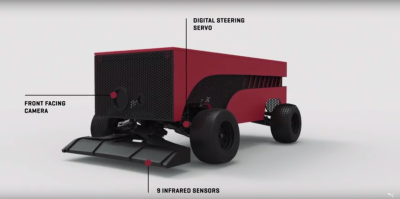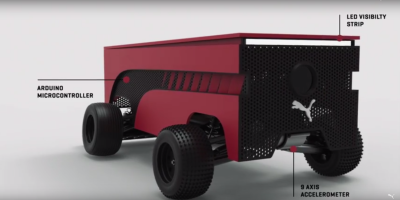Can your line following robot move faster than [Usain Bolt] who has been described as “The World’s Fastest Timed Human”? Puma, the athletic footwear, apparel and accessories company, created such a robot to help train their company sponsored athletes.
The shoebox-sized robot exceeds [Bolt]’s top speed of 44-km/hour. At that speed, following a line gets tricky. It took the development team 8 prototypes to attain that capability. Inside the BeatBot an Arduino reads 9 infrared sensors for line detection at 100 samples a second. A digital servo controls the Ackerman steering mechanism to follow the line on the track or floor. Wheel encoders provide the data for speed and distance measurement.
The user can set the distance of the run and the time to beat. Run pacing can also be adjusted. LEDs on the robot provide the starting ‘gun’ and help the runner see the BeatBot using peripheral vision. Two GoPro cameras, front and rear, provide a visual record of the run.
Puma believes that actually running against a competitor, even a robot, improves performance more than just running against the clock. They’re betting a grown-up line follower will help Olympic class athletes improve their performance.

















Kinda unexpected to say the least, but sure, add robots to sport events, im game.
Neat idea, though to be honest, I’d want to be giving it a bit more initial accelleration; Bolt quite easily beat it off the line. Kind of expected, but if you could pull a bit more acceleration out of it, you’d have the option of emulating a runner’s speed across the course of the race, rather than just their absolute time; Most people will start of fast and tail off towards the end (I think; don’t quote me on that), wheras the robot will be a bit more linear.
Wouldn’t it be easier to use a cat laser?
I’d have to velcro a stuffed rabbit to the top.
Did I see :
Traxxas Rustler
Tplink 703n
Webcam and Optical recog + wireless
This wouldn’t motivate me to run faster, but BigDog from Boston Dynamics on the other hand would be a better might tempt me to run faster.
Absolutely!
This is sad and incredible news, as I am dead-set on this being my summer project. I had decided about four months ago to build something like this, and it looks like Puma beat me to it. I’ve been doing tons of research and RC is definitely hard to understand. By wheel encoders, do they mean sensored brushless motors?
I’d encourage you to continue with your efforts. Puma is only releasing these to their sponsored athletes. They say it is because of cost. If you can do it a lot cheaper you might produce something that could be built and used by many others. It might make a Hackaday Contest entry as something benefiting people.
They didn’t provide many details on the build. They may have external encoders on the motors or wheels, or sensing on the brushless controller.
Good luck and let us know how it goes. Maybe you’ll make the Hackaday front page!
The hackaday post seems unsure if it would help performance but it most definitely would. Pacing a distance or sprinting running is essential to getting better times and training. Especially if you are the type of athlete who would prefer a solo track.
Do your project anyway. I think it will make a good starter for contests like fastest home-built line followers and use them on running tracks. You will learn something new that will help in future builds.
Did you notice that all the videos of the bot running were shot at night? Probably because standard line following sensors really suck in daylight conditions (cause they use IR). This really needs a sensor that works in daylight.
i’m interested to see what you can come up with anyways! there’s always more then one method to the same end goal.
Looks like a natural spot for a 360-degree camera for awesome footage of the race.
Maybe this has broadcast applications too.
I was totally thinking of the same thing!
Neat idea!
I read ‘line following robot trains’. Thought that would be easy if the line was down the middle of the tracks, and significantly harder if it deviated from the path of the tracks.
I suspect a camera would be better. I wonder if this could be used: http://charmedlabs.com/default/pixy-cmucam5/
I’ve seen blind runners being guided by sighted helpers, seems this might be able to replace those human helpers and allow the blind runners to perform to their full potential.
Now all one needs is a car with a sliding hatch in the floor and a little C-4, Gene Simmons on a killing spree and you have yourself a movie!
It’s like ghost racers in Mario Kart!
can you provide fritzing circuit diagram
Very good project. Make it affordable and it would be a great success. I would be very interesting to have an item like this one for helping même training.